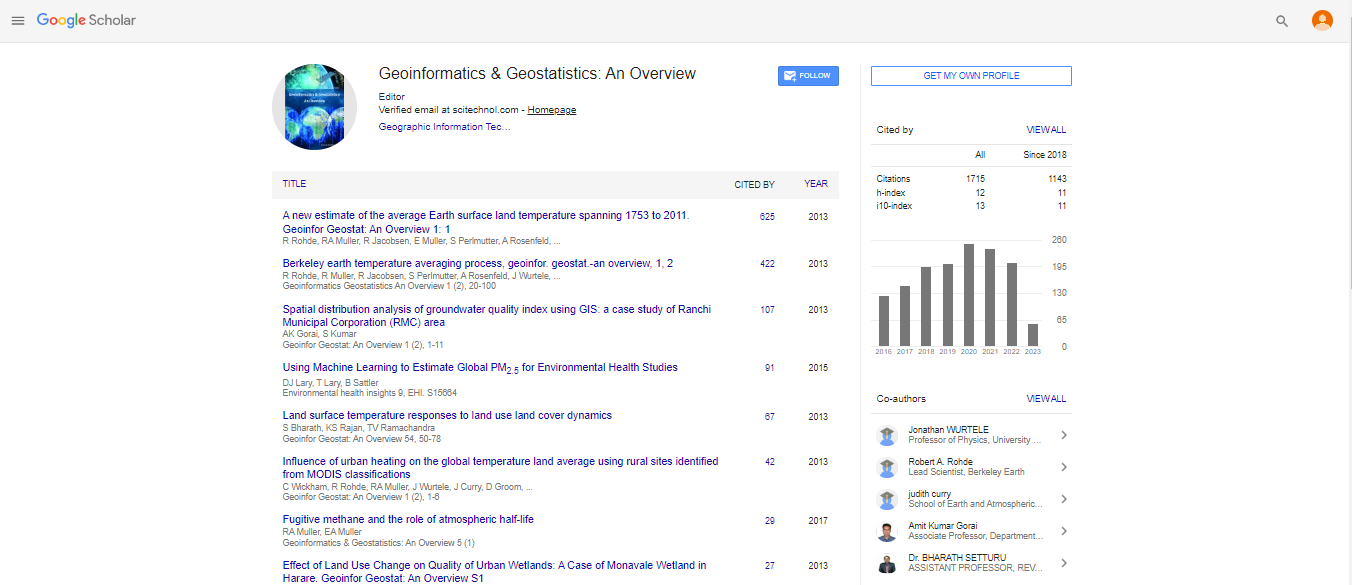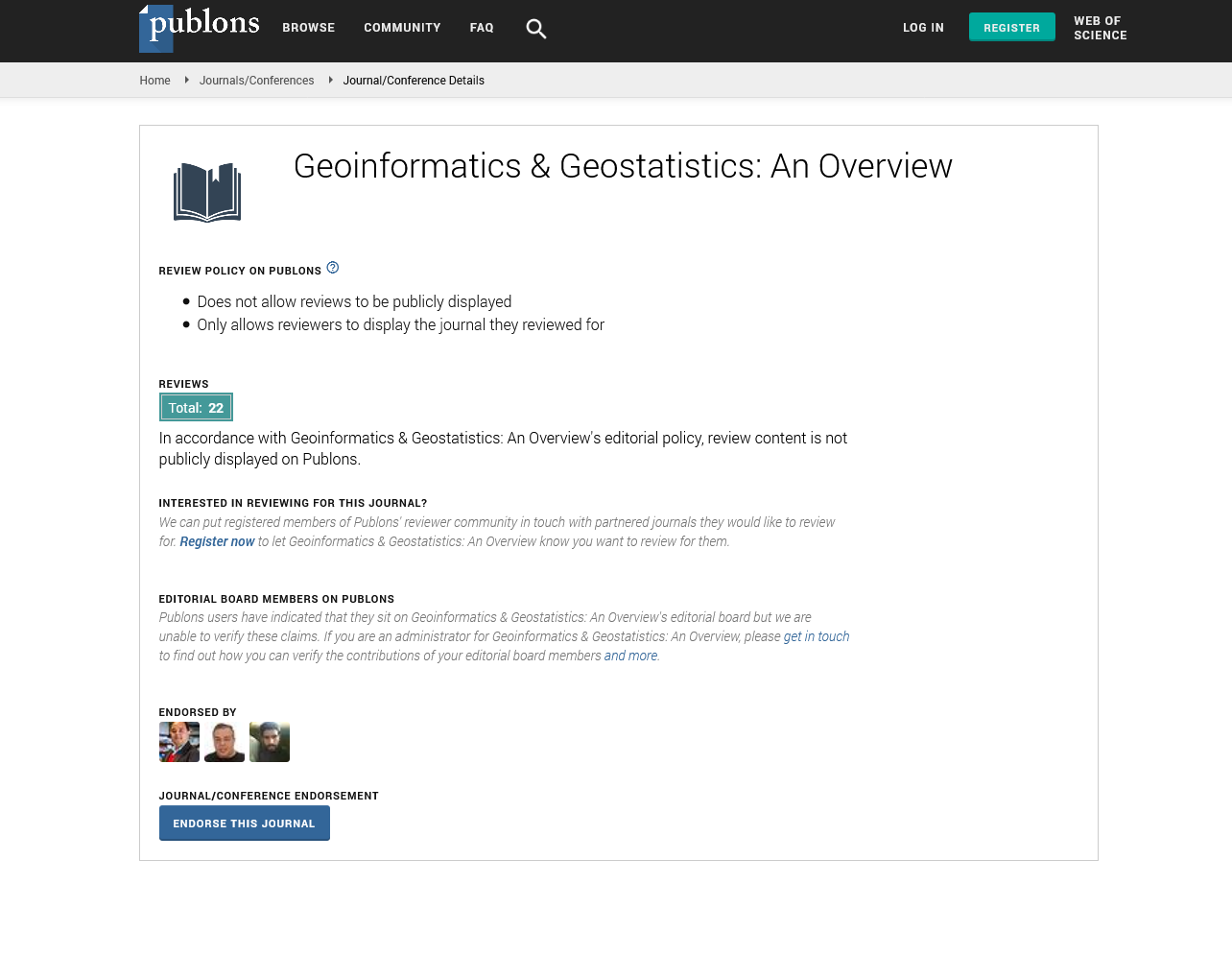Perspective, Geoinfor Geostat An Overview Vol: 12 Issue: 5
Geostatistical Techniques for Mapping Biodiversity in Protected Areas
Jasper Koles*
1Department of Geoinformatics, University of California, Berkeley, USA
*Corresponding Author: Jasper Koles,
Department of Geoinformatics, University
of California, Berkeley, USA
E-mail: jklh@berkeleyy.edu
Received date: 23 September, 2024, Manuscript No. GIGS-24-150362;
Editor assigned date: 25 September, 2024, PreQC No. GIGS-24-150362 (PQ);
Reviewed date: 09 October, 2024, QC No. GIGS-24-150362;
Revised date: 16 October, 2024, Manuscript No. GIGS-24-150362 (R);
Published date: 23 October, 2024, DOI: 10.4172/2327-4581.1000416
Citation: Koles J (2024) Geostatistical Techniques for Mapping Biodiversity in Protected Areas. Geoinfor Geostat: An Overview 12:5.
Description
Biodiversity is a critical indicator of ecosystem health and resilience, influencing everything from ecosystem services to climate regulation. Protected areas, such as national parks, play a vital role in conserving biodiversity by providing safe havens for various species. However, effective conservation requires accurate and detailed information about species distribution and diversity within these areas. Geostatistical techniques offer powerful tools for analyzing and visualizing biodiversity data, allowing researchers and policymakers to make informed decisions about conservation strategies. This essay explores the application of geostatistical methods in mapping biodiversity in protected areas, emphasizing their significance for conservation efforts.
Geostatistics is a branch of statistics that focuses on spatially correlated data. It provides a framework for analyzing and interpreting spatial patterns, making it particularly useful for ecological studies where data points are often collected at different locations and scales. Key geostatistical techniques includes a form of interpolation that estimates unknown values at unsampled locations based on values from nearby sampled points. It provides a best linear unbiased predictor, making it a powerful tool for creating continuous surfaces of biodiversity metrics. This technique quantifies spatial autocorrelation by assessing how data values change with distance. The variogram helps in understanding the spatial structure of biodiversity data, guiding the selection of appropriate interpolation methods. Measures the degree to which species occurrences are clustered or dispersed across a landscape. Techniques such as Moran's I can reveal patterns that may inform conservation strategies.
Biodiversity data, such as species presence, abundance, and environmental variables, can be gathered through field surveys, remote sensing and existing databases. For instance, citizen science initiatives and monitoring programs can provide valuable data on species distribution. Before applying geostatistical methods, researchers conduct exploratory analyses to understand the distribution and variability of the data. Visualization techniques such as histograms and scatter plots can reveal patterns and trends.
The variogram is important for understanding the spatial structure of biodiversity data. By analyzing the variogram, researchers can determine the range of spatial correlation, which informs the choice of interpolation techniques. For example, if species occurrence is highly autocorrelated over short distances, a local kriging approach may be appropriate. Once the variogram is established, kriging can be employed to create predictive maps of biodiversity. These maps visualize species distribution across the national park, highlighting areas of high richness or endemism. For example, a kriging map could reveal hotspots of plant diversity that warrant further conservation efforts.
It is essential to validate the geostatistical models by comparing predicted values with independent data. Techniques such as crossvalidation can help assess the accuracy of the predictions, ensuring that the mapping results are reliable. The final biodiversity maps can be visualized using Geographic Information Systems (GIS), which allows for dynamic exploration and interaction with the data. Effective visualization communicates complex spatial information to stakeholders, including policymakers, conservationists and the public.
Numerous case studies illustrate the application of geostatistical techniques in mapping biodiversity in national parks. For instance, research conducted in the Serengeti National Park has utilized kriging to map the distribution of large mammal species, providing insights into habitat preferences and potential human-wildlife conflict zones. Similarly, studies in the Amazon Rainforest have employed variogram analysis to understand the spatial distribution of tree species, informing sustainable management practices. Another example is the use of geostatistics in the Great Barrier Reef Marine Park, where researchers have mapped the distribution of coral species to assess the impacts of climate change and marine tourism. By identifying areas of high biodiversity, conservation efforts can be prioritized to protect these critical habitats.
Conclusion
Geostatistical techniques offer powerful methodologies for mapping and understanding biodiversity in protected areas like national parks. By analyzing spatial patterns and distributions of species, researchers can gain valuable insights that inform conservation strategies and policy decisions. The integration of geostatistics into biodiversity research not only enhances our understanding of ecological dynamics but also supports the sustainable management of natural resources. As the pressures on biodiversity continue to mount due to climate change, habitat loss and human activities, employing geostatistical techniques will be essential for effective conservation and the preservation of our planet’s rich biodiversity.
 Spanish
Spanish  Chinese
Chinese  Russian
Russian  German
German  French
French  Japanese
Japanese  Portuguese
Portuguese  Hindi
Hindi 
